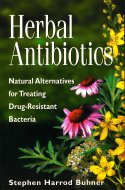
Book
Reviews
Book 24
Herbal Antibiotics – Natural Alternatives for Treating Drug-Resistant
Bacteria

by
Stephen Harold Buhner (1999) with foreward by James Duke pub. Newleaf, Dublin,
Ireland, 2000. ISBN: 0-7171-3130-0.
Copyright © Tony Burfield 2004.
James Duke straight away tackles the slightly contentious use of the term
“antibiotic” in the foreward, arguing that nature has developed beneficial
plant-protective phytochemicals with synergistic actions whose potential uses we
can no longer afford to ignore.
Throughout the next 134 pages, Dr. Stephen Buhner
a faculty member of the Rocky Mountain Centre for Botanical Studies, traces the
unique advantages of herbal antibiotics setting the scene with an introductory
chapter entitled “The end of antibiotics” which describes the development
and transmission of antibiotic resistance strains in bacteria, the result of
overuse. Buhner provides the example of farming in the US where half the
antibiotics consumed for the whole country (some 9,072,000 Kg per annum!) are
routinely fed to farm animals, which for example, might have had a part in
giving rise to well known pathogens such as E. coli
O157: H7.
Chapter two deals with Botanical Medicines, and
Buhner lists his top fifteen antibiotic herbs; many references to the actions of
individual herbs are given in the sixteen pagers of selected bibliography at the
back of the book. It would maybe give too much of “the plot” to specifically
to list these. One slightly controversial listing however might be for
grapefruit seed extract (Citrus paradisi) which the author admits “...
has proved impossible to discover the process used to make commercial GSE
(grapefruit seed extract)”. Several of us in the trade have believed up to now
that the action of GSE derives from the inclusion of a certain quaternary
compound – but maybe that’s another story! A useful 2-page table of
microbial pathogens and effective herbal treatments is also included in the
chapter, making reference to essential oils being the active principles in some
cases.
Chapter three deals with strengthening the immune
system, via a number of herbal strategies, as well as mentioning vitamins &
diet. Chapter four describes how to make use of herbal medicines for various
ailments. The book concludes with a glossary and selected bibliography as
mentioned above.
The level of the book is pitched about right –
it is not too technical, and suitable for a wide audience, but contains enough
interesting material and references, at a reasonable price, to perhaps tempt the
more academic researcher or health professional. Furthermore in spite of now
being a few years old, it is a timely read with the EU Biocides legislation
threatening the future of retailed natural products in disinfectants and
antiseptics etc. I would like to especially recommend this book therefore to
Health & Safety Executive officials everywhere, as important background!